Aikido AttacksUshiro relation Kogeki, the Attack Techniques in Aikido.Ushiro RelationThe ushiro relation is when the attacker comes from behind, or goes to the rear of the defender. In training, it is usually done so that uke starts from the front of tori, and steps behind him or her — often after initially grabbing one wrist or shoulder, as explained below.
Ushiro relation
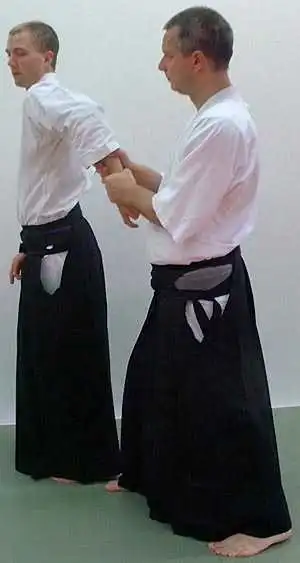 MorotedoriMorotedori (also called katate ryotedori) is when uke grabs one of tori's arms with both of his or her hands. Normally, it is not regarded as an ushiro form, and many aikidoka simply grab the arm in front of tori — but I see little meaning in such an attack form. Uke locks both of his or her arms, but only one of tori's, and still stands right in the way of tori. Not wise.I prefer it when uke grabs the arm and immediately steps behind tori, to the position showed on the photo above. There, uke is reasonably protected from tori countermeasures. Also, with such a grip on tori's arm, uke can quite easily block tori from spinning around. If the attack starts from the front, uke begins by grabbing tori's wrist in aihanmi style (right hand grabs right wrist, or left hand grabs left wrist). Immediately after that — preferably in a flowing movement — uke steps behind tori and applies the other hand. The morotedori grip is similar to that used in the yonkyo aikido technique. Actually, uke can increase the control of tori by applying yonkyo, if tori tries to spin around to that side. If tori tries to spin around to the other side, uke can stop that by moving tori's arm in that direction. If tori tries to kick, uke can block it my moving the arm down. Correctly applied, this is quite a good control grip. Observe that, because of the position of tori's arm and uke's hands on it, aikido techniques need to be done a bit differently from if uke grabs the arm straight in front of tori. Just like with any grip, it is important for uke to focus on the little fingers, and to have the sword grip style upward angle on the hands. Read more about the grip on aihanmi katatedori, above. To maximize power and control, it is also important for uke to have hands and feet in a correct position: when tori's right arm is grabbed, uke's left hand should have the highest grip (closest to tori's elbow), and uke's left foot should be in front. If tori's left arm is grabbed, then uke's right hand should grab above the left, and uke's right foot should be in front. This gives the best stability, and stops tori from easily lowering his or her elbow. Finally, uke should keep his or her elbows tight to the body, and not extended. Again, this increases the power of the grip significantly.
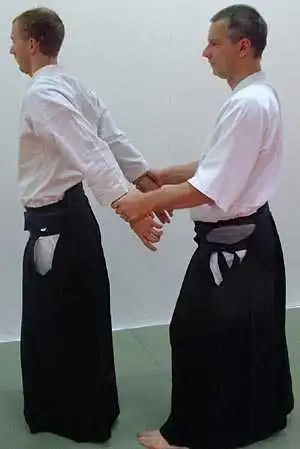 Ushiro ryotedoriUshiro ryotedori is when uke grabs both of tori's wrists from behind. Normally, this position is reached by uke first grabbing one of the wrists from the front, in aihanmi style (right hand grabs right wrist, or left hand grabs left wrist), and then stepping to tori's back to grab the other.Because of the way uke moves to get behind tori, and the way tori moves in taisabaki steps while uke proceeds, they will end up with opposite feet forward — if uke has left foot forward, tori has right foot forward, and vice versa. See the photo above. For example, if uke starts by grabbing tori's right wrist, then tori has right foot forward, and uke will round tori on tori's right side, to grab tori's left wrist from behind and stand with left foot forward. It seems complicated, but it's the most natural way of doing it, since uke will want to have the best balance for grabbing the second wrist, and that is accomplished by the foot on that side being forward. Regarding how the hands should do their grips, see aihanmi katatedori above. When uke has grabbed the first wrist, it is important to lower it, before going behind tori — or tori could easily hit uke with the elbow. In aikido, ushiro is never trained with katatedori, gripping just one wrist, since that is a very impractical attack form. The idea with most ushiro atacks, is that uke controls tori from behind and tries to stop tori from turning around — with just katatedori that is virtually impossible. For uke to try ushiro ryotedori, starting from in front of tori, tori's other arm must be reasonably available from the back. That is, tori has to let that arm drop to the side, or even hold it a bit backward, for uke at all to want to do ushiro ryotedori. If tori holds both of the hands in front of him or her, uke would be much more likely to grab ryotedori from the front, than to try for ushiro.
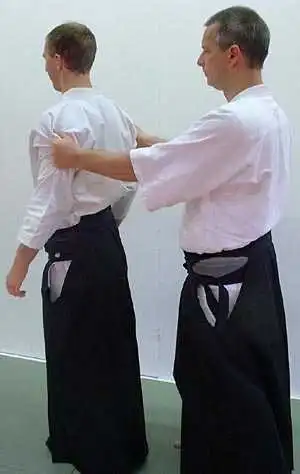 Ushiro ryokatadoriUshiro ryokatadori is when uke grabs both of tori's shoulders from behind. Similar to ushiro ryotedori above, this position is usually reached by uke first grabbing one of the shoulders from the front, and then stepping to tori's back to grab the other.The second shoulder is easier to find and grab from behind than the wrist, so here it is of little concern how tori positions him- or herself beforehand. Regarding the katadori shoulder grip itself, see katadori above. In aikido there is no ushiro training of katadori, gripping just one of the shoulders from behind, since that is impractical — just as stated above about ushiro katatedori (in the text about ushiro ryotedori).
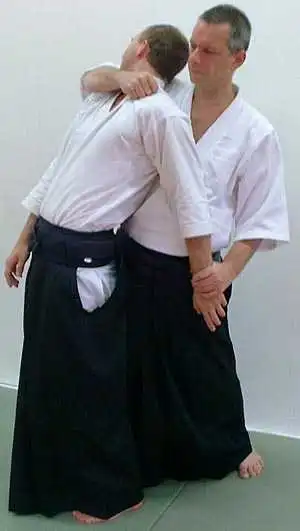 KubishimeKubishime is when uke locks tori's neck from behind, which is almost always done toegther with a katatedori grip on tori's wrist. Therefore the attack is also called katatedori kubishime. Since it is from behind, the full name of the attack would be ushiro katatedori kubishime, but the ushiro is taken for granted, since kubishime is not done from the front in aikido.If uke starts from the front, it begins with gripping one of tori's wrists, ai hanmi style (right hand grabs right wrist, or left hand grabs left wrist). Then, uke moves behind tori and applies the neck lock. The neck lock can be done in a number of ways, for example with or without grabbing tori's collar. On the photo above, it is done with a grip on the collar. Uke will have the best balance and stability, if the same foot is forward as the arm applying the neck lock. Also, uke should not position him- or herself right behind tori, but a little to the side of the wrist grip. This way, it is more difficult for tori to reach uke with the free hand. The reason for the katatedori grip is to lock one of tori's arms, so that tori has greater difficulty to counter the neck lock. Uke should strive to force tori back with the neck lock, so that tori stands in a backward arch. For maximum stability in the katatedori grip, uke should press tori's wrist toward his or her hip. See the photo above.
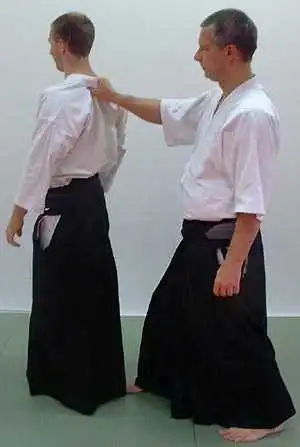 EridoriEridori is when uke grabs tori's collar from behind. Therefore, the complete name would be ushiro eridori, but the ushiro is taken for granted. To reach the back of the collar from the front, uke would have to be in a judo type clinch with tori — and then, surely, there must have been a preceding attack form for tori to act upon.Since the back of the collar is so difficult to reach from the front, even if uke starts by moving around toward tori's back, this might as well be trained by uke initially standing behind tori. For the best stability, uke should stand with the same hand and foot forward. Normally, but not necessarily, tori and uke will stand with the same foot forward. As with any grip, most of the power should be in the little finger, and the elbow should be pointing downward. Eridori is not a tremendously practical attack technique, but it is trained in aikido because it creates some complications for tori in doing the usual aikido techniques.
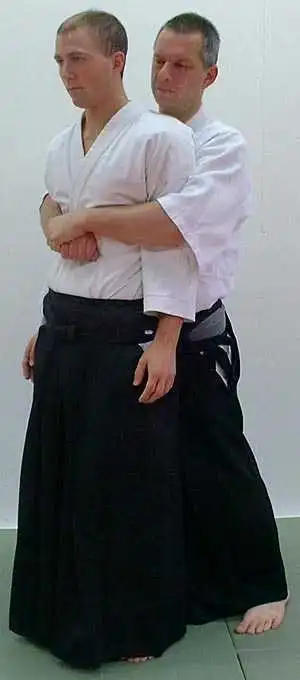 KakaedoriKakaedori is when uke grabs tori's body from behind. The complete name would be ushiro kakaedori, but the technique is rarely trained from the front in aikido, so the ushiro is taken for granted. In wrestling, grabbing the opponent from the front is common, so it could be interesting to practice in aikido. I guess that it is not done, because normally in aikido, one should act before uke gets near enough to apply the grip.This also means that the attack is regarded as a surprise from behind, so it might as well be trained with uke initially standing behind tori, instead of uke beginning in front of tori and moving to behind him or her. There are two ways of doing kakaedori. The most common one in aikido, is where uke grabs around tori's arms, too, as on the photo above. The other one is when uke grabs inside tori's arms, that is just the body. This is shown in the photo below. I have never heard that they have separate names — I guess mostly the first one is taken for granted. I recommend aikidoka to practice both forms, since they lead to quite different solutions for the aikido techniques.
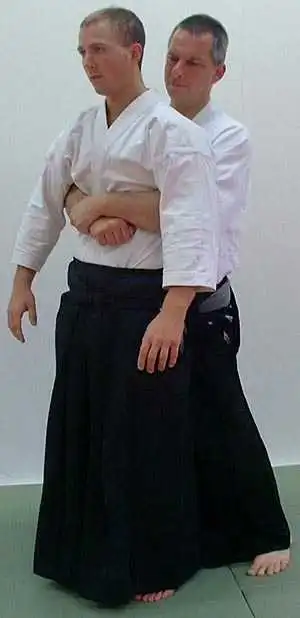 For the best stability, uke should stand with one foot back, not with feet together. The hands clasp in front of tori, at about solar plexus height, pressing him or her tightly toward uke. The clasp of hands can be done in many different ways, such as one hand grabbing the other by the ridge or the wrist, or the fingers of both hands hooking. It makes little difference. When doing the first form of kakaedori, apply it approximately at elbow height of tori's arms. If higher, it is too easy for tori to sneak under the grip, and if lower, too easy to get the arms out upward. With the second form of kakaedori, that has no significance, but you may want to apply it on tori's chest, not lower, otherwise he or she can turn around rather easily.
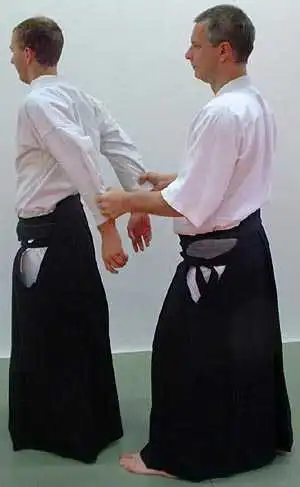 Ushiro ryosodedoriUshiro ryosodedori is when uke grabs both tori's sleeves from behind. Similar to ushiro ryotedori, it usually starts from the front, so that uke grabs one of the sleeves and then moves behind tori for the other one. Also the steps are done in the same way as for ushiro ryotedori, as well as how the foot positions of uke and tori are.This attack form is not done much in aikido, although it belongs to the curriculum. As mentioned about sodedori above, it is mainly of interest because of its lack of contact between uke and tori, compared to for example ryotedori. In ushiro, sodedori is never practiced with a grip on just one sleeve, since that is an impractical attack form. It is always both sleeves. Regarding the actual sleeve grip, see the text about sodedori, above. I would say that ushiro ryosodedori is the most interesting sodedori attack form to train in aikido. Tori will find it more tricky to do the aikido techniques, compared to ushiro ryotedori, and uke will find that gripping both sleeves actually makes for good control of tori.
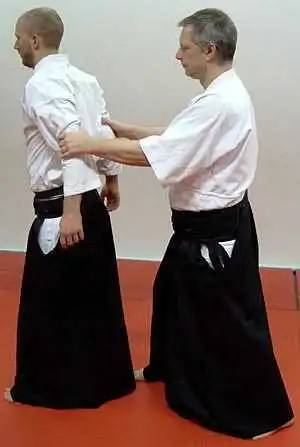 Ushiro ryohijidoriUshiro ryohijidori is when uke grabs both tori's elbows from behind. Similar to ushiro ryotedori, it usually starts from the front, so that uke grabs one of the elbows and then moves behind tori for the other one. Also the steps are done in the same way as for ushiro ryotedori, as well as how the foot positions of uke and tori are.This attack form is rarely done in aikido. In ushiro, hijidori is never practiced with a grip on just one elbow, since that is an impractical attack form. It is always both elbows. Grab the elbows firmly. It's not easy to hold on to elbows, since they are strong also on less muscular people. The ushiro form of this attack is more interesting to train than its frontside version, since the grab makes more sense from behind for uke. Also, it is interesting for tori to make sort of "narrow" versions of the ushiro ryotedori techniques, because uke is much closer and grabs higher on tori's arms.
AIKIDO PRACTICEIntroductionAikido Techniques — all the basic movesAttacks in Aikido
Tantodori — knife defenseAikiken — aikido sword techniquesJo 31 Kata in four directionsAikibatto sword and staff exercisesAiki — joining energiesKi exercisesAikido Video ClipsAikido PhotosMy aikido dojo in Malmö, SwedenMy aikido seminarsAIKIDO THEORYMy Aikido BioAikido GlossaryTanden, the CenterAikido InksAikido as Self-DefenseRunning a DojoAikido is TrueOsensei and EinsteinAikiWeb ColumnsAikido Books ReviewedDie deutsche Version meines Aikido-Buches onlineAikido på svenskaAbout CookiesMy Other WebsitesCREATION MYTHSMyths in general and myths of creation in particular.
TAOISMThe wisdom of Taoism and the Tao Te Ching, its ancient source.
LIFE ENERGYAn encyclopedia of life energy concepts around the world.
QI ENERGY EXERCISESQi (also spelled chi or ki) explained, with exercises to increase it.
I CHINGThe ancient Chinese system of divination and free online reading.
TAROTTarot card meanings in divination and a free online spread.
ASTROLOGYThe complete horoscope chart and how to read it.
MY AMAZON PAGE
MY YOUTUBE AIKIDO
MY YOUTUBE ART
MY FACEBOOK
MY INSTAGRAM
MY TWITTER
STENUDD PÅ SVENSKA
|
 Aikido Principles
Aikido Principles Attacks in Aikido
Attacks in Aikido Aikibatto
Aikibatto
